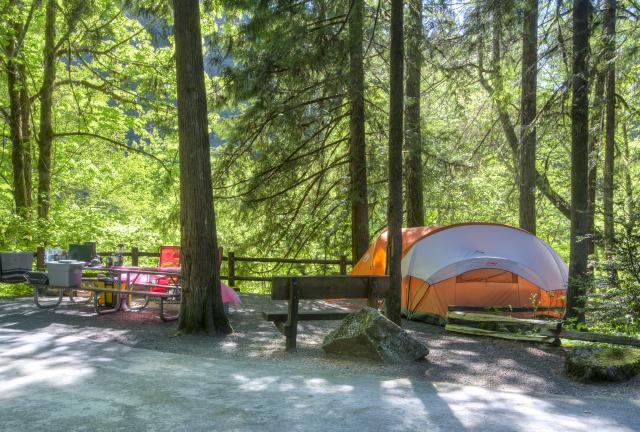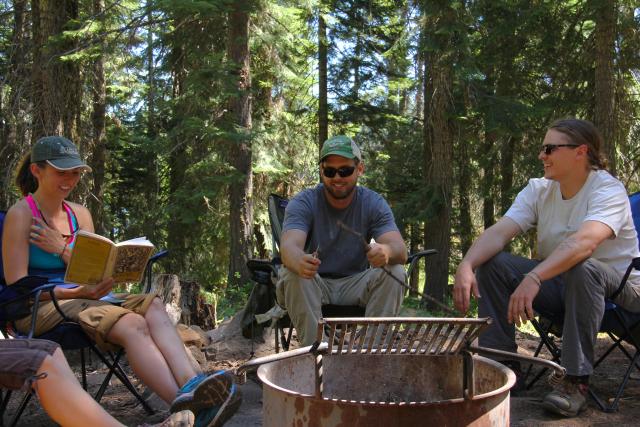Pitch Perfect: A beginner’s guide to camping adventures
Have you been thinking about going camping for the first time? It’s a great way to unplug, recharge, and enjoy the outdoors.
Fall camping offers a refreshing escape, with crisp air and cooler temperatures making hikes more enjoyable, campfires cozier and reservations a little easier. Surrounded by vibrant foliage and the quiet rustle of leaves, it's the perfect time to slow down and savor nature’s beauty.
Camping can feel overwhelming if you’ve never done it before, but don’t stress! We’re here to help. Just review our tips below and you’ll be ready to confidently plan your camping trip on public lands managed by the Bureau of Land Management.
1. Choose a Campsite That Matches Your Comfort Zone
Not ready to hike five miles into the wilderness with just a backpack? No worries! Start small with a car-accessible campground near home. Look for one with restrooms, running water, and maybe even cell service if that helps you feel more comfortable. You can explore further out, when you’re more experienced.

2. Plan Ahead
- Research your destination, know the rules, and have a backup plan.
- Check campground opening and closing dates.
- Look up the weather forecast.
- Book in advance: Popular campsites book-up quickly, especially in peak season. Secure your spot in advance through Recreation.gov. When you do this, you get the benefit of choosing your spot, seeing photos, and finding out which amenities are available (water, picnic tables, fire rings, etc.).
- Check if campfires are allowed. See local fire restrictions.
- Check if pets are allowed where you’re headed. If so, follow the leash regulations for the area. Don’t forget to pack food, water, leash and poop bags for your four-legged buddy!

3. Pack Smart
You don’t need to bring the entire outdoor section of the store. Bring the right gear for your comfort and safety and be sure you include items that are appropriate for the weather and season. Check the site description to see what’s provided and fill in the gaps with your own gear. Bring things that can serve more than one purpose and follow a checklist so you don’t forget something like your toothbrush!
Here’s what we recommend:
Essentials
- Tent (with stakes and rainfly)
- Ground tarp or tent footprint
- Sleeping bag
- Sleeping pad, cot, or air mattress
- Pillow (camping or regular)
- Flashlight or headlamp (with extra batteries)
- Camp chairs
- Table (if your site doesn't have one)
- Earplugs (nature can be noisy at night!)
- Trash bags (pack it in, pack it out)
- Lantern(s)
- Map(s)
- Food
- Drinking Water
Camp Kitchen
- Cooler with ice packs
- Water bottles
- Camp stove or grill
- Fuel for stove
- Lighter or waterproof matches
- Pots, pans, or griddle
- Cooking utensils (spatula, tongs, spoon)
- Plates, bowls, and cups
- Dining utensils
- Cutting board and knife
- Dish soap and sponge
- Paper towels or cloth towels
- Food storage containers/bags
- Meals and snacks (prepped, if possible!)
- S’mores Items: Marshmallows, chocolate, and graham crackers
Clothing & Personal Items
- Weather-appropriate clothing (layers are best!) -- Bring extra, you may need to change
- Sleepwear
- Hat and sunglasses
- Rain jacket or poncho
- Swimsuit
- Towel
- Toiletries (toothbrush, toothpaste, etc.)
- Sunscreen
- Bug spray
- Hand sanitizer
- Biodegradable soap
- Medications & first aid kit
Extras for Comfort & Fun
- Camera or binoculars
- Book, journal, or sketchpad
- Games (cards, frisbee, board games)
- Blanket or extra layers for chilly evenings
- Daypack for short hikes
Optional
- Hammock
- String lights
- Shade canopy
- Camping coffee maker or French press
- Firewood: Check if fires are allowed and if it’s sold on site. Don’t bring firewood from out of state – This risks spread of invasive species.
- Reusable water jug or collapsible container

4. Plan Your Meals Ahead of Time
Don’t wing it with food and keep it simple. Plan out what you’ll eat each day and prep as much as you can at home. Think: overnight oats, sandwiches, or pre-marinated veggies for grilling.
Always store food securely in sealed containers or bear-proof lockers to keep wildlife at a safe distance and your campsite clean.
In addition, please don’t feed wildlife.
5. Practice With Your Gear First
Don’t wait until you arrive to figure out how to pitch your tent. Try setting it up in your backyard or living room before your trip. The same goes for your camp stove, lantern, or air mattress. You'll thank yourself later.
6. Build a Safe Campfire
- Pick a safe spot: Use a designated fire ring or existing fire ring. If necessary, build your fire on bare soil, away from trees, tents, and dry grass.
- Keep it small: A manageable fire is safer and easier to control.
- Never leave it unattended: Always have someone watching the fire.
- Have water nearby: Keep a bucket of water or sand and a shovel close.
- Watch the wind: Strong winds can spread sparks quickly.
- Extinguish completely: Douse with water, stir the ashes, and repeat until cool to the touch.
- Follow local rules: Check for fire bans and/or restrictions in the area.
7. Arrive at Check-In Time or Before Dark
Arriving at your campsite around check-in time gives you plenty of daylight to set up, explore, and settle in without the stress of racing the sunset.
8. Maximize Fun
Camping isn’t just about firewood and bug spray. Some campgrounds also have hiking trails, fishing spots, or ranger programs.
One of the best parts of camping is the night sky. Far from city lights, you’ll get a front-row seat to a dazzling show of stars. So, grab a blanket, lean back, and let the galaxy do the talking.
9. Be a Good Neighbor
Camping is more fun when everyone is respectful. Follow the posted rules, keep noise levels down at night (sound travels far in the outdoors!), and keep a clean camp to help future visitors and protect wildlife. Also, preserve the beauty of the outdoors by following Leave No Trace principles. This means disposing of waste properly, respecting wildlife, and leaving your campsite better than you found it.
10. Can’t Go? Cancel or Update Your Reservation
If your plans change, be sure to update or cancel your reservation online. This gives someone else the chance to enjoy that campsite and helps keep things running smoothly for fellow campers.

So, now that you have learned more, are you ready to conquer your first camping excursion? Remember: It doesn’t have to be perfect to be unforgettable. We invite you to book that camping spot, unroll your sleeping bag, sleep under the stars and maybe conquer your first s’more (sticky fingers and all). Either way, the goal is to have fun, breathe in some fresh air, and make memories with your favorite people. Please do your part to prevent wildfire and don’t forget to pack your sense of adventure and snacks. Always bring plenty of snacks.
Krista Berumen, Digital Media Lead
Related Stories
- Take a First Day Hike on Your Public Lands
- Using science to uncover mysteries of the Mesa archaeological site in Alaska
- “Where did my horse come from?” BLM launches a new way for adopters, trainers and others to learn about their wild horses and burros
- Lake Havasu Fisheries Improvement Program is the gift that keeps giving
- Historic Umtanum Suspension Bridge wins international footbridge award
